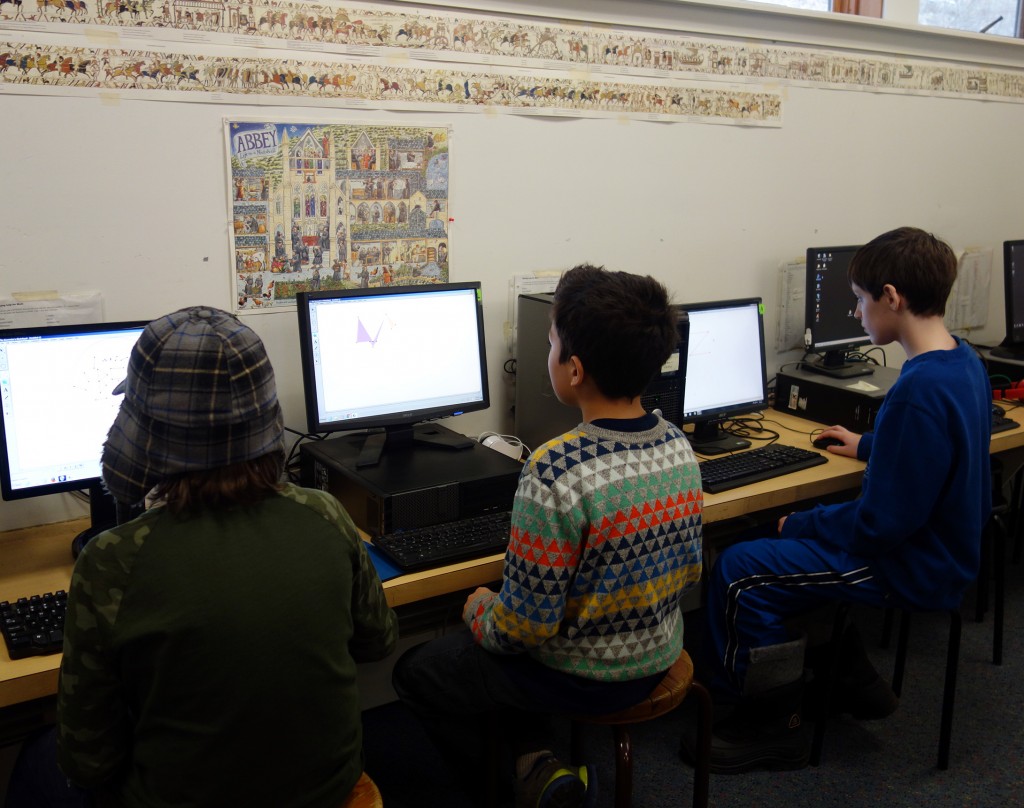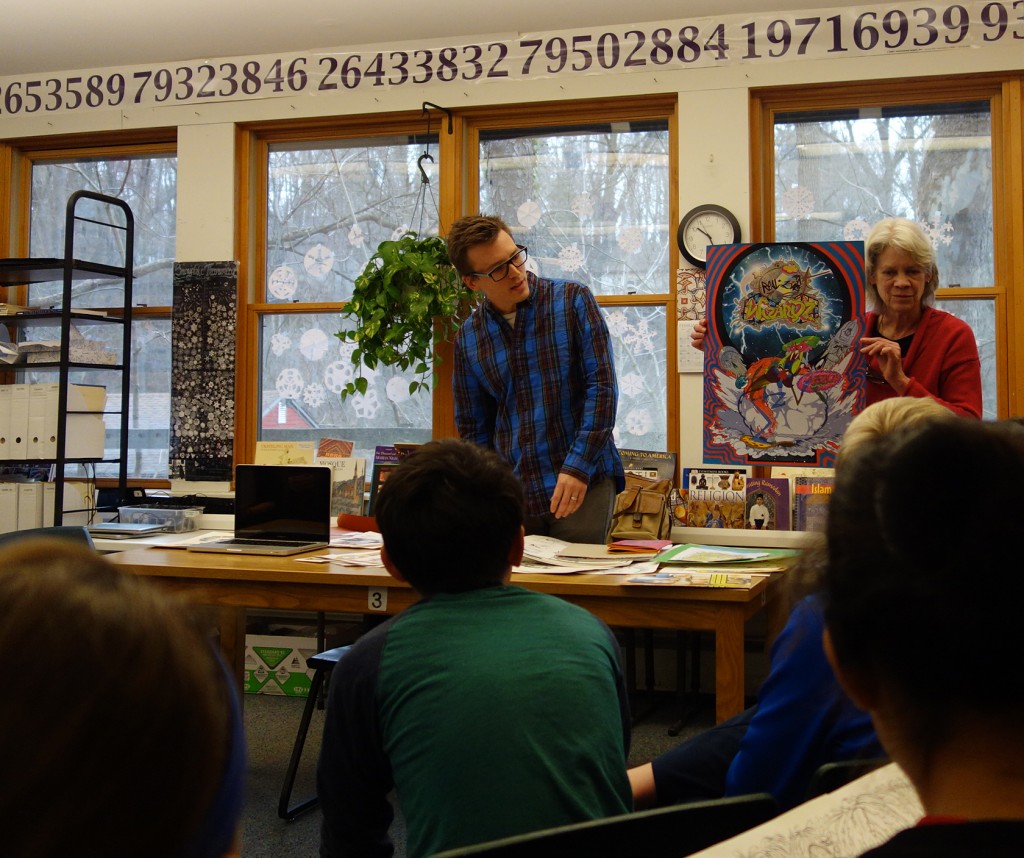As we finished up our introduction to Islam and the brief comparative religion study that was part of it, students printed out their research charts and brought them to the tables so we could sum up what we had learned. We found that the five main groups we investigated (Islam, Judaism, Christianity, Buddhism, and Hinduism) had some similarities as well as some differences. One god, multiple gods, or no gods at all? Houses of worship? Rituals and ceremonies? Religious leaders? Sacred texts? Foundation beliefs? Belief in an afterlife? Divisions and varying ideas within the belief system? Some students had time to choose and investigate other religions as well, including Shinto and Taoism. Some students learned some new things about their own religion. One thing we found was that all of these belief systems wanted people to treat each other well, and we agreed that — no matter what our personal world views might be — it seems like a very good idea, although not always easy to do.
We are now moving on to the Middle Ages in western Europe (primarily England). We have a wonderful collection of richly-illustrated resources, including The Oxford Children’s History, which contains concise 2-page chapters that give a clear introduction to large topics in British history. We began by skimming through a lot of the first pages to get an overview of what the people and events were that led up to armored knights galloping around on horseback and the social structures that supported them. For some students, it was largely a review of things they had learned at other times, but for most it was fairly new.
We saw the simple lives of the Celts; the arrival and departure of the Romans and their Christian religion; the gradual erosion of Christianity due to the invasions by polytheistic Angles, Saxons, Jutes, and Danes; the similarity between the lifestyles of those invaders and the Celts; missionary efforts to restore Christianity; the attacks and eventual settlement of the Vikings, and the transformation of the Norsemen (yes, those Vikings) into the Normans (with chivalry and the French language and the feudal system in their package). We are about to look closely at what happened in 1066, which included the Battle of Hastings and the establishment of William the Conqueror as the first Norman king of England.
As we did with Islam, we gave out an introductory vocabulary list and have done a couple of activities with it to help students master the new words they will need: manor, serf, and fief are just a few from the list. We will continue to work with making new vocabulary secure throughout this unit, both in context and through focused worksheets and puzzles.
There will be connections with other topics we have explored this year. The resurgence of Christianity in Europe led to the crusades and the many attempts to overthrow Muslim control of what Christians saw as “their” holy land. Of course, it was (and is) holy to the Jews and Muslims, too, so we still see that conflict raging today. The Mongols’ stirrups and effective use of cavalry in battle led to the development of the European knight in armor. We saw a very impressive catapult as part of the Genghis Khan exhibit at the Franklin Institute, and we will be building much smaller ones in the classroom as we learn about ways to attack and defend a castle.
______________________
Our production of “Macbeth: The Musical Comedy” is part of this study, although somewhat loosely connected. We began by reading/telling the general plot of the Shakespeare play so that students would understand the parody and jokes embedded in the musical. (This is one of many delightful scripts that comes from Bad Wolf Press, including “Rumpus in the Rain Forest” and “Tide Pool Condos” that have been performed by younger groups at Miquon in years past.) We have a collection of graphic novels that also tell Shakespeare’s original tale, some in his actual words and some in much simpler language. Some of our students have enjoyed looking at several versions and comparing the way the story is told.
Our casting of the play was done the way we always do it: after familiarizing everyone with the script so they can see the size and nature of the parts, we draw names out of a hat and let students choose their roles from those that are available. We assume that everyone is capable of doing the parts they choose, and we have never been disappointed. This year, we have a rather humorous situation, in that Lady Macbeth is being played by one of our boys and Macbeth by one of our girls. At this point, almost everyone knows their lines (including the students with the largest parts) and are making progress with the songs. Next week, we’ll work with costumes and props, preparing for our performances on March 16. One will be at 9 am for the entire school and the other in the evening for families at 6:30.
________________
Our six different math groups are moving forward with their array of topics. Several are working on fractions, one on algebra and problem-solving strategies, and one on angles and plane geometry in general. Students in every group are encouraged to find multiple solutions to their problems and to share their work so classmates can see that there are often many paths to the same destination. In the photo below, one group is at the board to discuss how they worked out a puzzle-like piece of homework from the previous day.
This photo shows the geometry group learning about the features of Geometer’s Sketchpad, which is a wonderful piece of software for discovering and constructing all kinds of mathematical knowledge. (It runs on Macs as well as PCs and is available as a one-year student license from the publisher for $9.95. Your child might be interested in having it at home.)
_______________
We finished up the editing of our “framework” stories, printed them out, and bound them in individual copies along with the illustrations and covers that students created. There is also a single unified collection in a binder that will remain in the classroom after the individual books go home during conference week. The stories are built around a generic structure that we gave out in installments, but they are delightfully different from each other and reflect both the creativity and interests of our group. Some of the stories are funny, some are dramatic and serious, and each is unique.
_______________
Art teacher Anne Brady organized an amazing 2-day symposium for all of the 5th/6th graders. She brought in 6 different artists (including some Miquon alumni) to talk about their work as professionals. Students asked excellent questions as they learned about the many different ways an artist might make a living.




